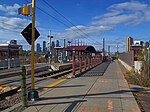Little Earth Trail
Bike paths in MinnesotaRail trails in MinnesotaShared-use paths in MinneapolisTransportation in MinneapolisUse mdy dates from January 2020

Little Earth Trail is an approximately 1-mile (1.6 km), multi-use bicycle path in Minneapolis, Minnesota, United States, that links several neighborhoods, parks, businesses, and trails in the Phillips community. The trail begins at its northern end near the intersection of East Franklin Avenue and 16th Avenue South and eventually follows the west side of Hiawatha Avenue to the Midtown Greenway and Martin Olav Sabo Bridge. Named after the nearby Little Earth community, the shared-use pathway provides transportation and recreation opportunities, and is a frequent location of activism on social justice issues in Minneapolis.
Excerpt from the Wikipedia article Little Earth Trail (License: CC BY-SA 3.0, Authors, Images).Little Earth Trail
Little Earth Trail, Minneapolis
Geographical coordinates (GPS) Address Nearby Places Show on map
Geographical coordinates (GPS)
| Latitude | Longitude |
|---|---|
| N 44.9557 ° | E -93.2434 ° |
Address
Little Earth Trail
Little Earth Trail
55404 Minneapolis
Minnesota, United States
Open on Google Maps







